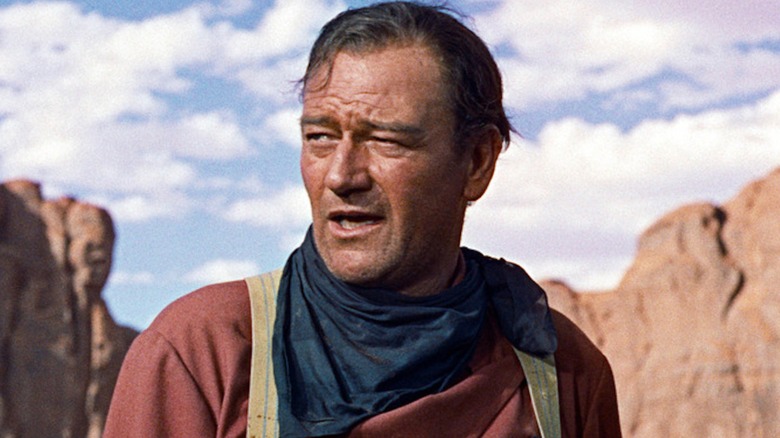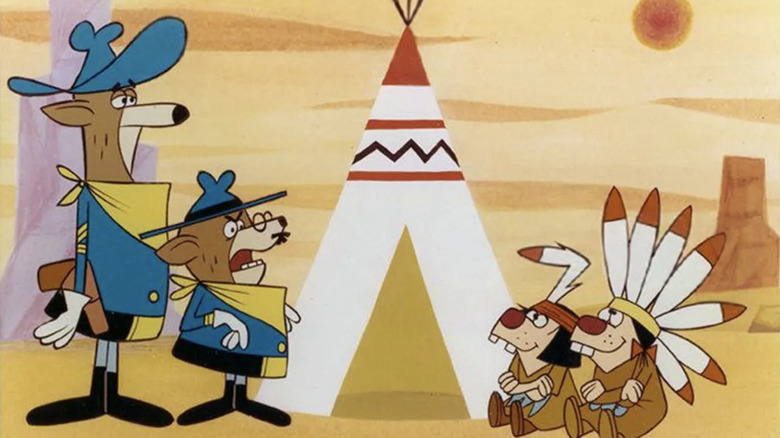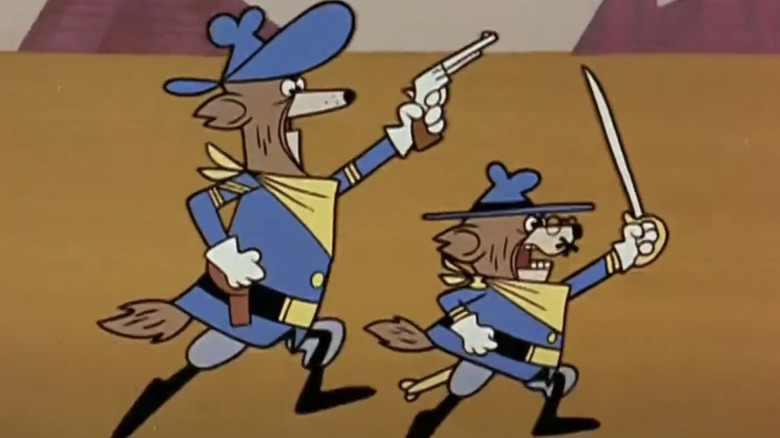An Obscure Western Cartoon Parodied John Wayne
John Wayne's firm cowboy drawl is easily imitated, as shown by Robin Williams, Phil Hartman, and many more. Peter Cullen's voice as Optimus Prime in "The Transformers" is sometimes compared to Wayne too (though Cullen cites a different inspiration).
One of the less famous Wayne impressions came from Sandy Becker, a radio announcer and early TV show host turned voice actor, in the 1960s comedy Western cartoon "Go Go Gophers." Set in the 1870s or so during the U.S. westward expansion, the series is a parodic look at the U.S. army's attempt to drive out Native Americans from their land. Unlike real life, the cavalrymen always fail to make the Natives leave.
Leading that cavalry are two anthropomorphic coyotes: Colonel Kit Coyote (Kenny Delmar) and Sgt. Okey Homa (Becker). The two have often been described as caricatures of President Theodore "Teddy" Roosevelt and John Wayne, respectively, and you can see that in their character designs. Roosevelt was a real American hero of this era, and Wayne retroactively became one by appearing in so many Hollywood Western movies. The coyotes aren't the heroes of this show, though. That's the two remaining "Gopher Indians," Running Board (George S. Irving) and Ruffled Feather (Becker), who always manage to outwit the coyotes (often with the help of their anachronistic inventions).
"Go Go Gophers" ran for 48 five minute episodes, produced as segments in the Superman parody cartoon, "Underdog." Though obscure today, the "Underdog" family of cartoons were released on DVD during the 2000s, which caught my young eye after the 2007 live-action "Underdog" movie had first introduced me to the series. I grasped the slapstick of "Go Go Gophers" (it's hard not to) but I didn't have the cultural context of kids who watched in the '60s. At that time, Westerns had been the dominant Hollywood entertainment for decades, spreading stereotypes of the old West that this cartoon both used and satirized.
Go Go Gophers has and hasn't aged well
Sixty years on, "Go Go Gophers" is definitely not politically correct by today's standards. The very fact that the gophers are called "Indians" and not "Native Americans" reflects that. They're based more on stereotyped Natives from Western movies, not the real deal, and so are caricatures of caricatures.
Running Board speaks in broken English and Ruffled Feather talks only in gibberish, ostensibly his native tongue. This marks them both as "other" and "uncivilized" even if it belies that they're both quite intelligent. The craft is hardly spectacular, too; the animation is rather cheap and simplistic, a la contemporary Hanna-Barbera cartoons, and the plotting is repetitive.
Retrospective reviews of "Go Go Gophers" are mixed. Some hone in on the stereotypes and/or criticize turning the historical crimes against Native people into a farce. Yet the Native characters are not the ones treated as the most farcical. In American Westerns, cowboys were always the good guys and Natives always the bad guys. Even more nuanced films, like Wayne's "The Searchers," still often depicted the Natives as savage raiders for white settlers to fear. "Go Go Gophers" understood that the Natives were the ones under siege in the first place and trying to protect said settlers from taking their land.
Go Go Gophers satirized Western films and Manifest Destiny
In "Go Go Gophers," the Natives are fun-loving pranksters against stodgy authority, and they're the ones who always win. Conversely, the Colonel is credulous and pompous. The Sergeant is more cool-headed and likable but still goes along with his boss. The pair end most episodes lying in a daze after taking a dynamite explosion to the face.
It's for these reasons that "Go Go Gophers" has also been called subversive and progressive for its time. Part of the satire is who the program parodied as the buffoonish Colonel and hapless Sergeant. Teddy Roosevelt was an avowed imperialist who infamously claimed: "I don't go so far as to think that the only good Indian is the dead Indian, but I believe nine out of every ten are, and I shouldn't like to inquire too closely into the case of the tenth."
John Wayne didn't just star in many films that promoted manifest destiny and the lost cause of the Confederacy, he was a hard right-winger in real life. At the 1973 Oscars, Marlon Brando declined his Best Actor win for "The Godfather" to protest Hollywood's demonization of Native Americans; he asked Native activist Sacheen Littlefeather to attend the ceremony and decline in his place. A rumor eventually arose that Wayne, who was in the crowd, had to be held back from attacking Littlefeather, but that could very well be a myth.
In "Go Go Gophers," stand-ins for Roosevelt and Wayne get shown up, episode after episode, by the people they denigrated in life.


